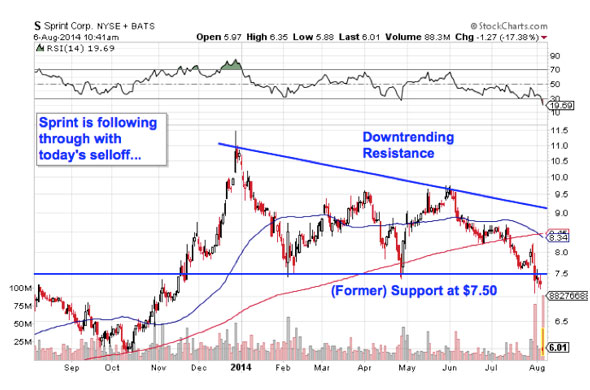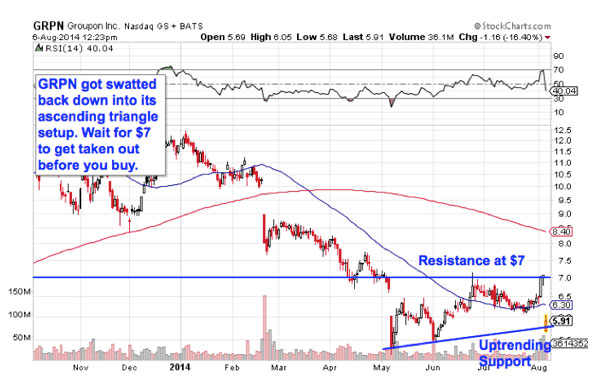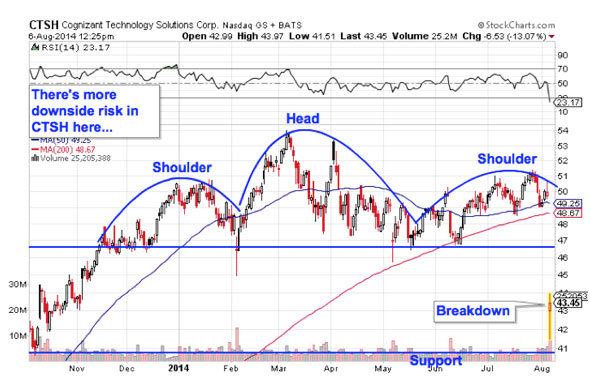DELAFIELD, Wis. (Stockpickr) -- At Stockpickr, we track daily portfolios of stocks that are the biggest percentage gainers and the biggest percentage losers.
Stocks that are making large moves like these are favorites among short-term traders because they can jump into these names and try to capture some of that massive volatility. Stocks that are making big-percentage moves either up or down are usually in play because their sector is becoming attractive or they have a major fundamental catalyst such as a recent earnings release. Sometimes stocks making big moves have been hit with an analyst upgrade or an analyst downgrade.
Read More: 5 Breakout Stocks to Trade for Gains
Regardless of the reason behind it, when a stock makes a large-percentage move, it is often just the start of a new major trend -- a trend that can lead to huge profits. If you time your trade correctly, combining technical indicators with fundamental trends, discipline and sound money management, you will be well on your way to investment success.
With that in mind, let's take a closer look at a several stocks under $10 that are making large moves to the upside.
Read More: Warren Buffett's Top 25 Stocks for 2014
Conatus Pharmaceuticals
Conatus Pharmaceuticals (CNAT), a biotechnology company, focuses on the development and commercialization of novel medicines to treat liver diseases in the U.S. This stock closed up 1.9% to $7.85 in Tuesday's trading session.
Tuesday's Range: $7.50-$8.03
52-Week Range: $5.06-$15.67
Tuesday's Volume: 318,000
Three-Month Average Volume: 672,625
From a technical perspective, CNAT jumped notably higher here right above its 50-day moving average of $7.36 with lighter-than-average volume. This stock recently formed a double bottom chart pattern at $7.28 to $7.29. Following that bottom, shares of CNAT have started to spike higher and move within range of triggering a big breakout trade. That trade will hit if CNAT manages to take out its 200-day moving average of $8.25 to some more near-term overhead resistance at $8.41 with high volume.
Traders should now look for long-biased trades in CNAT as long as it's trending above its 50-day moving average at $7.36 or above those double bottom support zones and then once it sustains a move or close above those breakout levels with volume that hits near or above 672,625 shares. If that breakout materializes soon, then CNAT will set up to re-test or possibly take out its next major overhead resistance levels at $9.69 to $9.90, or even $10.50.
Read More: 3 Big M&A Stocks on Traders' Radars
Arch Coal
Arch Coal (ACI) produces and sells thermal and metallurgical coal from surface and underground mines located in the U.S. This stock closed up 6.6% to $3.05 in Tuesday's trading session.
Tuesday's Range: $2.92-$3.12
52-Week Range: $2.82-$5.37
Tuesday's Volume: 10.90 million
Three-Month Average Volume: 5.59 million
From a technical perspective, ACI gapped up sharply higher here right above its 52-week low of $2.82 with monster upside volume flows. This stock has been downtrending badly for the last three months and change, with shares moving lower from its high of $5.37 to its recent low of $2.82. During that move, shares of ACI have been consistently making lower highs and lower lows, which is bearish technical price action. That said, shares of ACI are now starting to rebound off that $2.82 low with volume and a possible trend reversal could be at play. Market players should now look for a continuation move to the upside in the near-term if ACI manages to take out Tuesday's intraday high of $3.12 with strong volume.
Traders should now look for long-biased trades in ACI as long as it's trending above Tuesday's intraday low of $2.92 or above its 52-week low of $2.82 and then once it sustains a move or close above $3.12 with volume that hits near or above 5.59 million shares. If that move begins soon, then ACI will set up to re-test or possibly take out its next major overhead resistance levels at $3.36 to its 50-day moving average of $3.44. Any high-volume move above those levels will then give ACI a chance to tag its next major overhead resistance levels at $3.75 to its 200-day moving average of $4.11.
Read More: 5 Stocks Set to Soar on Bullish Earnings
Iao Kun Group
Iao Kun Group (IKGH) promotes VIP gaming rooms in Macau, the People's Republic of China. This stock closed up 4.2% to $3.22 in Tuesday's trading session.
Tuesday's Range: $3.12-$3.25
52-Week Range: $2.57-$4.26
Tuesday's Volume: 129,000
Three-Month Average Volume: 47,843
From a technical perspective, IKGH ripped higher here right off both its 50-day and 200-day moving averages at $3.13 with strong upside volume flows. This spike higher on Tuesday briefly pushed shares of IKGH into breakout territory, since the stock flirted with some key near-term overhead resistance at $3.22. Shares of IKGH are now quickly moving within range of triggering an even bigger breakout trade. That trade will hit if IKGH manages to take out Tuesday's intraday high of $3.25 to some more key overhead resistance at $3.36 with high volume.
Traders should now look for long-biased trades in IKGH as long as it's trending above Tuesday's intraday low of $3.09 or above more near-term support levels at $3 to $2.95 and then once it sustains a move or close above those breakout levels with volume that hits near or above 47,843 shares. If that breakout triggers soon, then IKGH will set up to re-test or possibly take out its next major overhead resistance levels at $3.55 to $3.61, or even $4 to its 52-week high at $4.26.
Read More: 5 Rocket Stocks to Buy for August Gains
Heron Therapeutics
Heron Therapeutics (HRTX), a specialty pharmaceutical company, develops product candidates using its proprietary Biochronomer polymer-based drug delivery platform. This stock closed up 2.4% to $9.20 in Tuesday's trading session.
Tuesday's Range: $8.87-$9.28
52-Week Range: $0.44-$15.82
Tuesday's Volume: 140,000
Three-Month Average Volume: 193,087
From a technical perspective, HRTX bounced notably higher here with lighter-than-average volume. This stock has been downtrending badly for the last month, with shares moving lower from its high of $12.70 to its recent low of $8.23. During that downtrend, shares of HRTX have been consistently making lower highs and lower lows, which is bearish technical price action. That said, shares of HRTX have now started to bounce off that $8.32 low and it's starting to move within range of triggering a big breakout trade. That trade will hit if HRTX manages to take out Tuesday's intraday high of $9.28 to some more near-term overhead resistance at $9.50 with high volume.
Traders should now look for long-biased trades in HRTX as long as it's trending above some near-term support at $8.76 or above that recent low of $8.32 and then once it sustains a move or close above those breakout levels with volume that hits near or above 193,087 shares. If that breakout gets underway soon, then HRTX will set up to re-test or possibly take out its next major overhead resistance levels at $10.57 to its 50-day moving average of $10.92, or its 200-day moving average of $11.11.
To see more stocks that are making notable moves higher, check out the Stocks Under $10 Moving Higher portfolio on Stockpickr.
-- Written by Roberto Pedone in Delafield, Wis.
RELATED LINKS:
>>4 Hot Stocks to Trade (or Not)
>>3 Stocks Breaking Out on Unusual Volume
>>5 Toxic Stocks You Should Sell This Summer
Follow Stockpickr on Twitter and become a fan on Facebook.
At the time of publication, author had no positions in stocks mentioned.
Roberto Pedone, based out of Delafield, Wis., is an independent trader who focuses on technical analysis for small- and large-cap stocks, options, futures, commodities and currencies. Roberto studied international business at the Milwaukee School of Engineering, and he spent a year overseas studying business in Lubeck, Germany. His work has appeared on financial outlets including
CNBC.com and Forbes.com.You can follow Pedone on Twitter at www.twitter.com/zerosum24 or @zerosum24.










 Related BZSUM Fed Says Districts Were Optimistic On Economic Outlook; Yahoo! Falls On Downbeat Results Yahoo Falls On Downbeat Results; Time Warner Shares Spike Higher
Related BZSUM Fed Says Districts Were Optimistic On Economic Outlook; Yahoo! Falls On Downbeat Results Yahoo Falls On Downbeat Results; Time Warner Shares Spike Higher 
 Related UNG Natural Gas Supplies Rise; Gas Stocks See Slight Drop Natural Gas ETF To Face Pressure; Japan Inspires Bets On Casino ETF Related SEA These ETFs May Provide Traction After Transports Stall How To Set Sail With Shippers Guided By Options
Related UNG Natural Gas Supplies Rise; Gas Stocks See Slight Drop Natural Gas ETF To Face Pressure; Japan Inspires Bets On Casino ETF Related SEA These ETFs May Provide Traction After Transports Stall How To Set Sail With Shippers Guided By Options 

